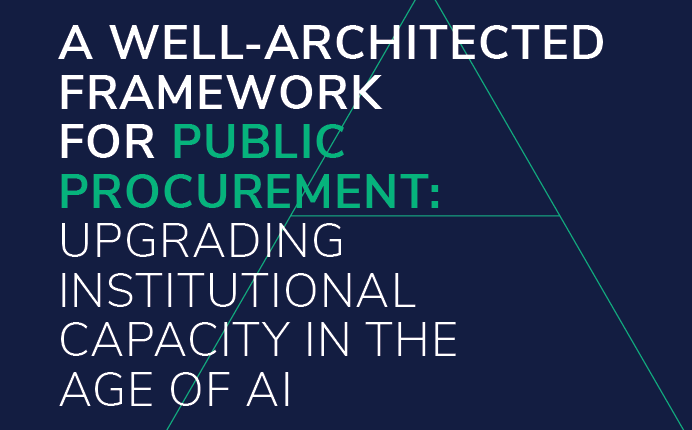In short
At TIAL’s latest event, procurement finally had its moment in the spotlight — not as bureaucracy’s dull(er) cousin, but as a secret weapon for institutional innovation. Geoff Mulgan and Leonardo Quattrucci unpacked how redesigning procurement can unlock agility, talent, and better outcomes. Participants — experts and practitioners from around the world — eagerly shared clever hacks and real-world wisdom, proving procurement might just be the most overlooked tool for transforming governance in the era of AI.
On May 20th, 2025, we hosted an online event titled “Fixing Procurement for the Era of AI“, convening policymakers, experts, and practitioners to discuss public procurement as a strategic lever for institutional transformation in a rapidly digitising world. Geoff Mulgan (TIAL) moderated the session, featuring a keynote by Leonardo Quattrucci (Centre for Future Generations and Sciences Po) based on a white paper he wrote for TIAL, and an active dialogue among participants.
Opening remarks, by Geoff Mulgan
Geoff Mulgan opened the event by highlighting procurement’s paradoxical nature. Despite representing 12-13% of GDP in developed economies, procurement often remains under-recognised and overshadowed by less impactful issues dominating policy discussions. He stressed procurement’s significant but untapped potential to enhance government effectiveness, particularly given rapid technological advances, such as AI.
Geoff encouraged participants to rethink procurement not just as an administrative function, but as a powerful strategic tool that, if well-architected, could profoundly impact public-sector innovation and performance.
“A Well-Architected Framework for Public Procurement”, by Leonardo Quattrucci
Leonardo outlined key insights from TIAL’s white paper, presenting procurement as central to government capacity in an era defined by exponential technological advancement.
“Public procurement accounts for 12% of GDP in developed economies. That’s more than Western Europe spent on pandemic response during COVID. Every year, we spend more than an emergency response on buying things of all sorts.”
Given the importance of procurement, Leonardo articulated several critical challenges:
- Rigidity and slowness: Traditional procurement doesn’t suit rapidly evolving technologies.
- Skills gap: Procurement officers frequently lack the necessary competencies to evaluate complex, emergent technological solutions.
- Perverse metrics: Current incentives focus on inputs (cost, volume), rather than outputs (innovation, user experience, public value).
To address these challenges, Leonardo introduced the “Well-Architected Framework for Public Procurement“, emphasising four principles:
- Adaptability – Institutions should continuously evolve, like software.
- Agility – Procurement must speed up decision-making to keep pace with technological change.
- Accuracy – Matching procurement skills precisely to the technological needs.
- Accessibility – Lowering barriers for innovators by improving transparency and clarity.
Leonardo also stressed the importance of institutional innovation—encouraging experimental approaches, such as DARPA’s “tour of duty” talent model and agile procurement practices like hackathons.
“Software that does not constantly evolve is outcompeted, vulnerable to threats, and abandoned by users. The same can be true for institutions.”
Insights from participants
Participants shared diverse perspectives, underscoring procurement’s complexity and potential:
- Anir Chowdhury (Executive Director of TIAL and formerly with the Government of Bangladesh) identified three key bottlenecks: outdated laws, cumbersome processes, and skill deficiencies. He advocated for innovative procurement practices, such as hackathons and MVP-based models, to circumvent rigid structures.
- Marcello Coppa emphasised that procurement in Italy often lacks centralised strategic coordination, and performance metrics tend to emphasise individual compliance rather than collective innovation and learning.
- Ben Hawes shared insights from the UK’s Innovation Procurement Empowerment Centre (IPEC), highlighting the critical role of competence centres in professionalising innovation procurement.
- Kristin Wolff argued that procurement should be viewed as strategic investment, not merely administration. She emphasised outcome-oriented metrics aligned with public value.
- Erdem Ovacik, founder of a mobility startup in Denmark, described his experience implementing outcome-based procurement marketplaces, rewarding services based on measurable public benefits, such as shifts in transportation habits.
The lively discussion also addressed practical implementation issues:
- Outcome-based procurement:
Rohan Samarajiva asked about practical examples of successful outcome-based procurement. Participants cited Singapore’s model (highlighted by Sriganesh Lokanathan in the chat), which tests multiple providers simultaneously and narrows down based on effectiveness and user experience. - Skills and talent:
Participants asked how governments can attract and retain procurement talent. Leonardo suggested purpose-driven recruitment and short-term, flexible placements like DARPA’s “tour of duty”. - Cross-sectoral procurement:
Adler Yang raised concerns about structural and cultural barriers hindering cross-agency collaboration. Leonardo and Geoff agreed this remains a significant challenge, stressing experimentation and institutional redesign as critical first steps. - AI for procurement:
Participants including Rohan Samarajiva and Kristin Wolff discussed using AI to simplify procurement processes. Leonardo noted practical barriers (such as PDF and JPEG document incompatibilities) but agreed that AI could streamline operations if underlying organisational architecture is redesigned accordingly.
Resources shared by participants
Participants shared numerous valuable resources, reflecting procurement’s broad, transversal nature and different approaches:
- Ben Hawes shared resources from the UK Innovation Procurement Empowerment Centre, including their Procuring Innovation Playbook and Ada Lovelace Institute’s research on procuring AI in local government.
- Sriganesh Lokanathan linked Singapore’s comprehensive guide on Outcome-Based Procurement.
- Erdem Ovacik highlighted his Danish startup, Impact Market, designed to facilitate outcome-based procurement and behavior-driven payments.
- Leonardo Quattrucci shared “Poseidon’s Paradox,” exploring challenges with automating procurement using AI: Poseidon’s Paradox.
- Luca Cominassi shared Spain’s ALIA, a framework focusing on leveraging public AI effectively.
- Petra Sipari from Finland shared their National Procurement Strategy, emphasising societal impact through procurement.
What’s next?
Closing the session, Geoff Mulgan reiterated the potential of procurement as a significant strategic asset, deserving far greater attention and thoughtful institutional redesign. Leonardo proposed concrete follow-up steps, including developing case studies and playbooks informed by participant input, to practically apply and refine the well-architected principles.
This event highlighted procurement’s centrality in institutional innovation, reinforcing TIAL’s vision of responsive, agile, and adaptive governance.
We thank all participants for their insightful contributions and invite the community to continue this conversation, helping us shape procurement as a lever for systemic transformation.
The full paper, “A Well-Architected Framework for Public Procurement,” can be read here.
Read more
Event recap: Fixing procurement for the era of AI
Institutional innovation and institutional design start to garner media attention
White paper #002: A Well-Architected Framework for public procurement
Featured image: your-photo / iStock.



